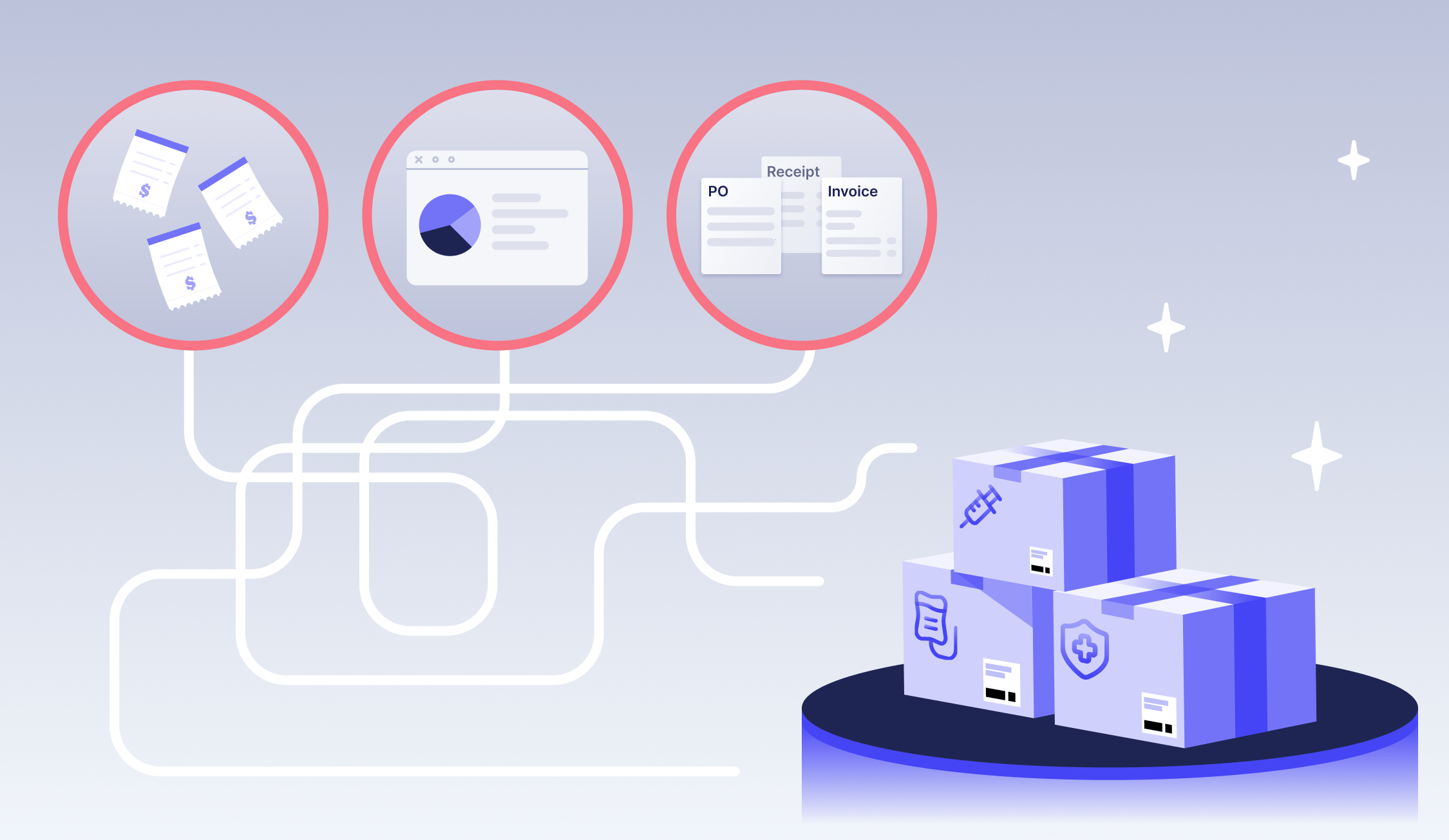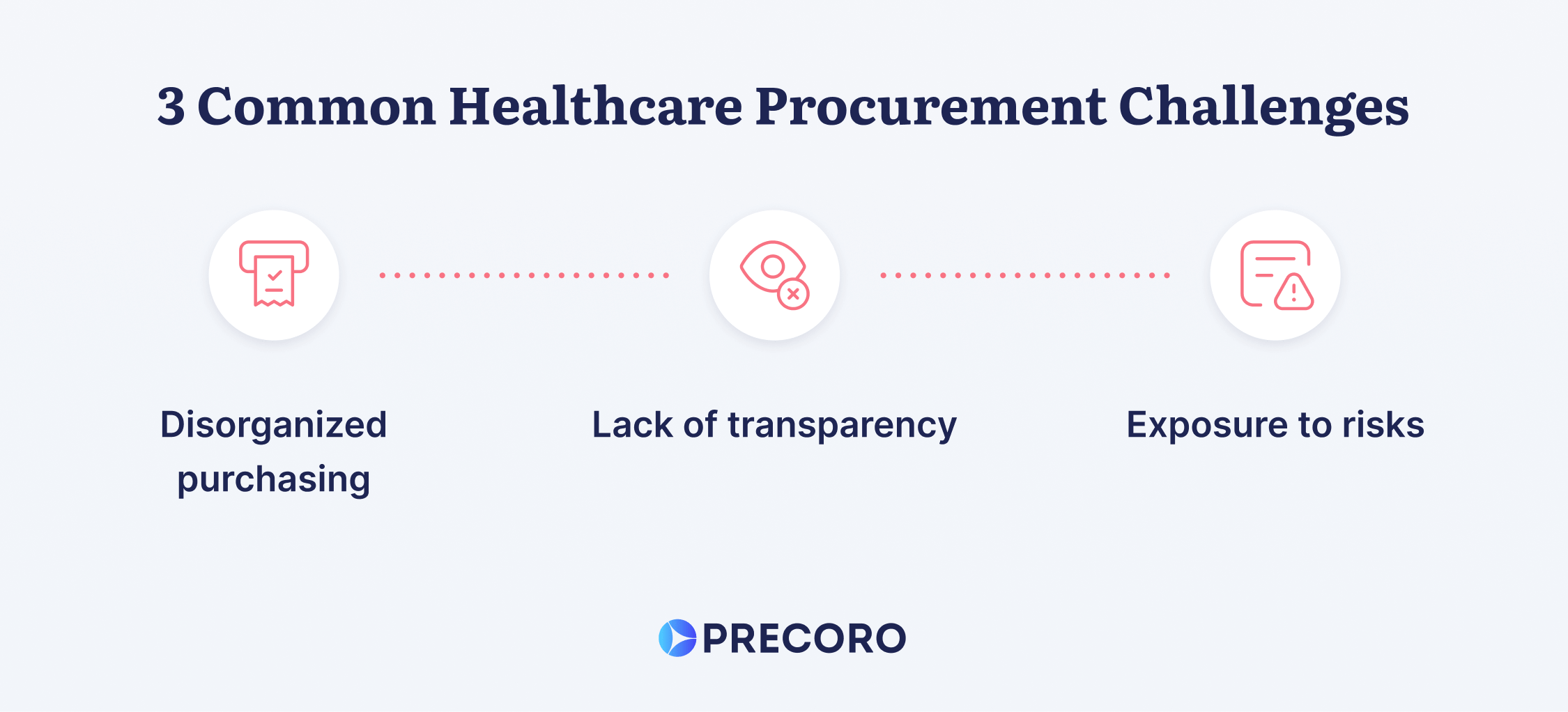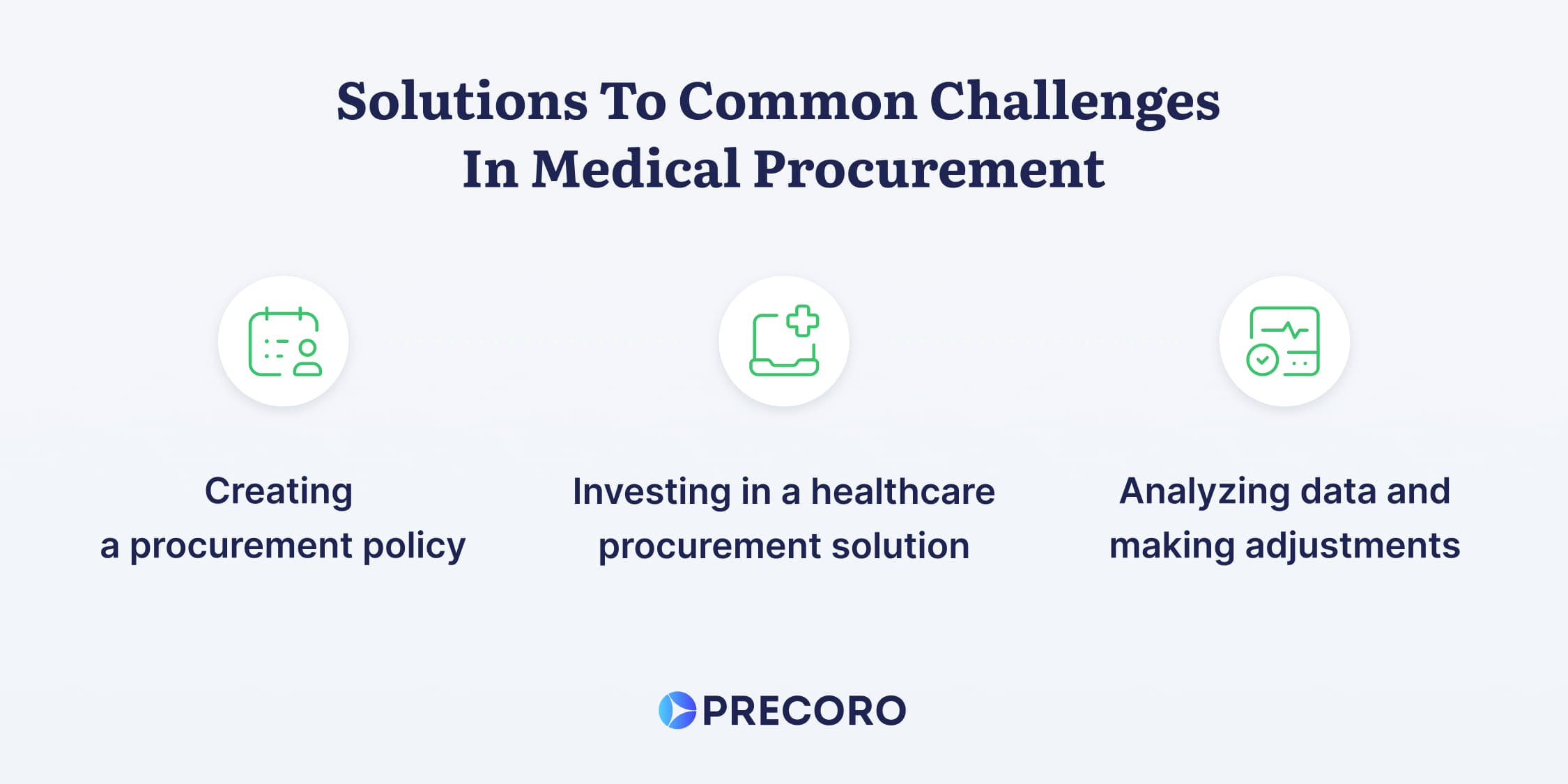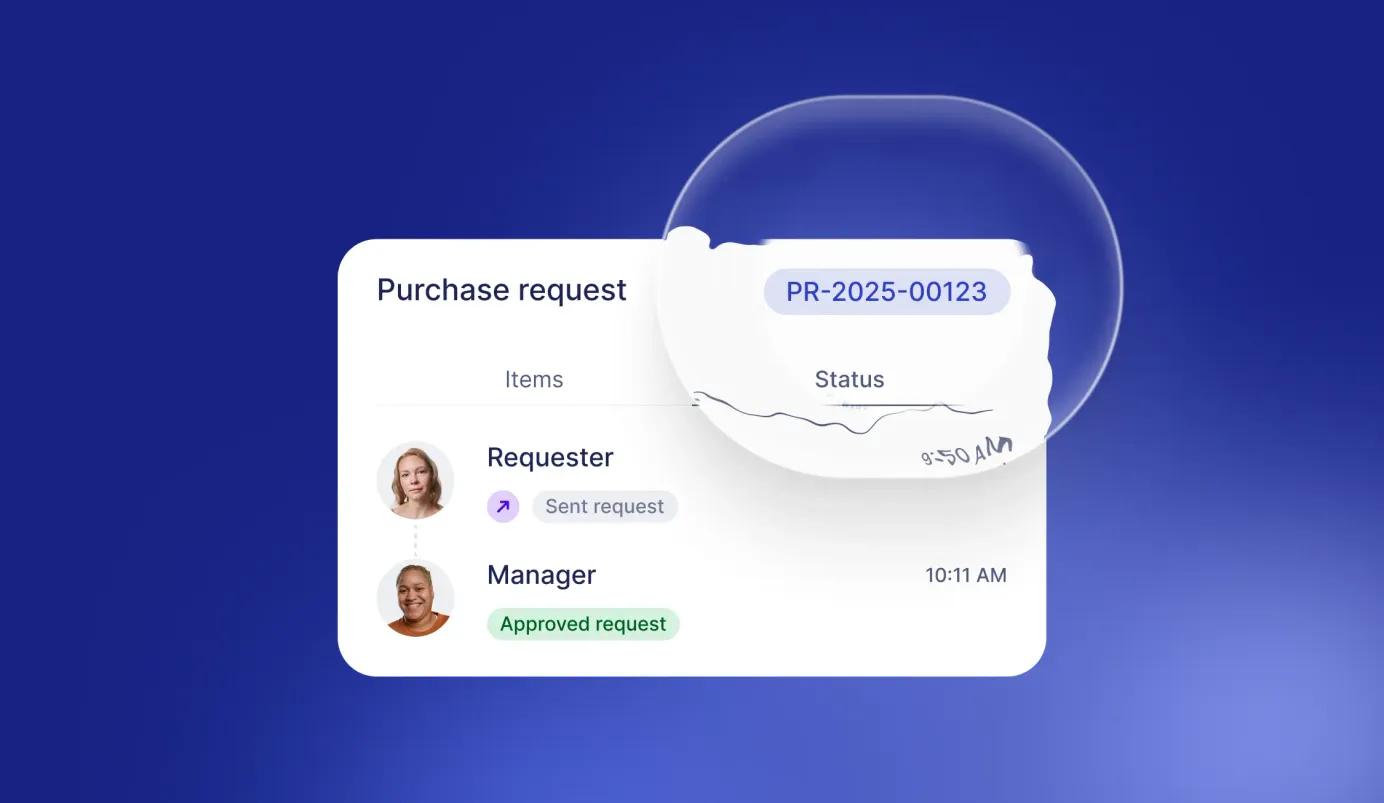
9 min read
Healthcare Procurement: 3 Common Challenges and Their Solutions
Healthcare procurement faces challenges like disorganized purchasing, limited visibility, and risk of fraud and human errors. Learn how to efficiently tackle them.
Medical institutions might not typically consider optimizing the healthcare procurement process a top priority. Yet procurement in healthcare influences the overall well-being of medical institutions and, ultimately, the quality of patient care.
Healthcare procurement is a multifaceted process that involves managing suppliers, requesting healthcare products, approving the requests, monitoring inventory, tracking expenses, and overseeing budgets. Additionally, procurement operations engage various employees across different departments and locations, who have to take on the roles of requesters, approvers, purchasers, receivers, managers, and budget analysts.
The involvement of numerous stakeholders and multi-step activities leads to certain hurdles. Let’s delve into the primary challenges encountered in healthcare procurement and identify their causes, implications, and efficient solutions.
Keep reading to find out:
- The Essence of Healthcare Procurement
- Our Top 3 Healthcare Procurement Challenges
- Solutions to Common Challenges in Medical Procurement
The Essence of Healthcare Procurement
Healthcare procurement is the process of acquiring equipment, goods, and services for clinics, hospitals, rehabilitation centers, and other medical institutions. Similar to procurement in other industries, the medical procurement process encompasses the following steps:
- Identifying the suppliers;
- Negotiating and signing contracts;
- Requesting and approving purchase orders;
- Verifying invoices;
- Receiving the ordered items and creating receipts;
- Managing inventory;
- Keeping procurement documents for spend analytics and audits.
However, procurement in the healthcare industry has some unique aspects. For starters, healthcare products must comply with certain standards and regulatory rules like NHS procurement standards or WHO Quality assurance policy for the procurement of essential medicines and other health products.
Secondly, maintaining the quality of goods, ensuring reliable logistics, and meeting volume needs are literally a matter of life and death in the healthcare industry. That’s why efficient inventory management is especially vital in the medical industry and is key for providing high-quality healthcare services.
Thirdly, healthcare organizations usually have multiple locations and require bulk orders, meticulous shipment control, and real-time visibility into inventory levels across multiple facilities. Thus, effective supply chain management demands seamless cooperation among various stakeholders and departments.
Our Top 3 Healthcare Procurement Challenges
We’ve compiled the most common challenges the healthcare industry faces in procurement, what causes them, and the risks they entail.
Disorganized purchasing
The absence of a unified procurement policy results in decentralized purchasing across the healthcare organization. In practice, it means that different departments procure medical equipment and medicines independently, either from the same or different vendors. Moreover, individuals within a department may also make separate purchases of the same goods.
When this happens, the medical institution misses out on potential discounts that could have been leveraged through bulk orders or negotiations after consistent ordering from the same supplier. The high volume of small orders also contributes to longer delivery times. Overall, disorganized purchasing leads to poor supplier management and unnecessary spending.
Lack of transparency
Poor visibility into procurement practices can manifest in a few ways, namely:
-
Limited visibility into vendor offerings
This problem arises when the medical institution doesn’t send out requests for proposals to potential vendors before deciding on the preferred one. As a result, the organization can’t compare prices and delivery terms from different providers and may end up with a vendor that does not have the most favorable terms. -
Unclear order fulfillment
Without a centralized procurement system, requesters may experience a lack of transparency in the order fulfillment process. It is unclear whether their purchase orders have been approved and sent to suppliers and whether the corresponding invoice and receipt have been created. As a result, the requester and approver must engage in prolonged back-and-forth communication, especially if changes to the purchase order are required. -
Insufficient inventory tracking
When inventory levels aren’t visible to requesters, they can’t quickly check whether the item they need has already been bought and end up placing an unnecessary order. The other negative implication is the high risk of supply shortage, especially if there’s no notification system that promptly informs employees when certain goods reach a low stock level. -
Lack of spend analytics
Inefficient record keeping and a lack of analysis lead to a lack of proper visibility into spending. As a result, the medical organization can’t track how much is spent on each vendor and item category, missing out on identifying opportunities for cost savings.
Fundamentally, the primary root cause in all the above-mentioned cases lies in the absence of a comprehensive system that would shed light on procurement practices for all stakeholders.
Exposure to risks
The third challenge is exposure to risks. While this can apply to pretty much any industry or process, what stands out about procurement is that many organizations rely on spreadsheets. When it comes to healthcare, it’s especially important to eliminate fraud or errors that might impede receipt of equipment for patient care:
-
Fraudulent or duplicate invoices
Usually, when organizations pay for the invoices, they have to cross-reference them with the corresponding purchase order and receipt. This process, known as three-way matching, helps buyers ensure that items, quantities, prices, and terms are the same across the documents. However, employees can easily overlook some discrepancies when conducting 3-way matching manually, especially when they have to process a large number of invoices. As a result, the medical institution can suffer financial losses and legal implications. -
Human errors in purchase requisitions and purchase orders
Just as with three-way matching, creating requests for goods or services entails a risk of oversight. For example, when employees get a list of different budget lines, they can easily make mistakes in selecting the appropriate one during the request creation. Such errors contribute to unclear budget allocation. -
Data integrity challenges
This problem is specific to spreadsheet-based healthcare procurement processes. With multiple users having access to editing spreadsheets and data entry errors, healthcare providers can face difficulties tracking changes over time and keeping accurate procurement records.

Solutions to Common Challenges in Medical Procurement
There are three proven ways to tackle the challenges we discussed in the previous section. Let’s consider them in detail.
Creating a procurement policy
To eliminate maverick spending and ensure that employees make only approved purchases, the medical institution should provide them with a standard procurement policy. Creating guidelines for efficient healthcare procurement requires addressing key questions:
-
Should employees create a purchase requisition (PR) first or skip it and go straight for a purchase order (PO)?
-
If it makes more sense for your healthcare organization to have both PRs and POs, should a requester create a purchase requisition, send it for approval, and then convert it into a purchase order? Or, instead, should the operations officers or other designated personnel create purchase orders based on approved requests?
-
How many steps of approvals do you need for each type of procurement document (a purchase requisition, a purchase order, an invoice, a receipt)? Should they be parallel or sequential?
-
Would you prefer separate approval workflows for purchases under and over 500 dollars (or any other sum of money)?
-
May employees order from any vendor, or should they choose only from the list of preferred suppliers?
-
Should employees send requests for proposals to potential suppliers and have new suppliers go through the internal approval process?
-
What categories of goods and services does your institution usually need (such as medical equipment, pharmaceuticals, or IT services)?
-
How much money does each department need per quarter and per year?
-
Should approvers immediately decline POs that exceed the predefined budget, or is there a tolerance limit?
The procurement policy is usually created by the procurement department with the help of the finance team. It’s also a good idea to bring in external consultants to help internal teams analyze current processes and develop best practices that would suit your medical institution.
Investing in a healthcare procurement solution
While a policy tells staff how to engage in procurement activities, disorganized buying can still occur due to the time-consuming and cumbersome nature of manual procurement processes. Some may find it easier to skip a required step or two than to seek multiple approvals and engage in back-and-forth communication regarding the requests.
By implementing a procurement platform tailored to its region, for example, the USA, the UK, Australia, and South Africa, the organization ensures compliance with local regulations and encourages all employees to adhere to established policies.
Beyond compliance, medical procurement solutions also provide much-needed visibility and simplify procurement activities for requesters, approvers, and management. Let’s take Precoro as an example and explore how purchasing software can simplify operations for healthcare providers:
-
Requesters can quickly create purchase requisitions and purchase orders with easy-to-use customizable templates.
-
The medical institution can set up supplier and item catalogs within the system to avoid manual data entry.
-
The organization can avoid incomplete requests by making document fields mandatory and adding drop-down menus that simplify the requesting process.
-
The system enables multi-level approval workflows for different types of procurement documents. It’s possible to create separate approval routings based on locations, departments, projects, and sums of money.
-
Approvers receive timely notifications for pending documents and have visibility into available budgets before making decisions.
-
The system can immediately reject the PRs or POs that exceed the budget if the key user makes the appropriate adjustments.
-
The software enables users to send requests of proposals to potential suppliers to compare their offerings before issuing a PO.
-
Both requesters and approvers can check the status of each order and see whether it’s been fulfilled.
-
It’s possible to create one PO from multiple PRs to group orders from the same supplier.
-
The management and other designated users can monitor available budgets in real time and track expenditures.
-
The system enables delivery tracking and stock transfers. Moreover, it allows users to set up notifications about low inventory levels, ultimately preventing supply shortages that can be detrimental to patient care.
-
The system enables 2- and 3-way matching to verify invoices and prevent fraud.
-
Precoro is fully GDPR-compliant and ensures robust data security through Single Sign-On (SSO) and reliable two-factor authentication.
To ensure active employee engagement with the system, opt for a user-friendly platform with positive reviews. It’s also important to look for a highly customizable solution that can be adjusted according to your organization's specific procurement policy.
Analyzing data and making adjustments
Automated procurement solutions come with the added benefit of data visibility. Data from stored documents like POs, receipts, supplier info, and expenditure data can be leveraged to further optimize the procurement process and ultimately minimize spend.
The 2022 PWC Global Digital Procurement Survey highlights cost reduction as the top strategic priority for procurement departments in the healthcare industry. To achieve this, companies can do the following:
-
Optimize spend by category
Evaluating spending with category management proves to be very beneficial for healthcare organizations. If the same items are purchased within the same period by different departments, grouping them and making big orders is a great way to reduce the frequency of deliveries and get volume discounts. -
Analyze supplier expenditure
It’s also a good idea to examine expenditures per supplier. Suppose an organization notices that a substantial amount of its budget is consistently spent with one supplier. Once they recognize this, they can inquire about discounts or more favorable terms based on the volume of business. Alternatively, if they discover that the same category of goods is sourced from various suppliers, they can decide to consolidate orders with a single supplier to reduce costs. -
Review departmental spending
Analyzing expenditures per department is a great practice for enhancing budget forecasting and finding opportunities for cost savings. For instance, such analysis can determine which department is responsible for overspending the budget. Then, appropriate corrective measures can be taken. -
Compare quarterly budgets
By comparing quarterly budgets to track spending trends over time, medical institutions can identify seasonal variations and adjust budget allocations accordingly. This is a valuable step for proactive financial planning and resource management.

Efficient Healthcare Procurement in a Nutshell
Healthcare procurement is the process of acquiring medical supplies and other goods and services essential for efficient patient care and the productive work of medical personnel, administration, and management within medical facilities. As this process involves many steps and stakeholders, procurement in the healthcare industry entails some challenges:
- Disorganized purchases that result in maverick spending, inefficient inventory management, and missed opportunities for cost savings;
- Limited visibility into vendor offerings, order status, inventory levels, and spending;
- Risk of fraud, human errors, and data security breaches.
Introducing a healthcare procurement policy is essential to ensure authorized purchases across different departments and facilities. However, implementing rules is just the beginning of optimizing medical procurement; actively assisting employees in adhering to them and analyzing the results is crucial. That’s when healthcare procurement solutions come into play.
A procurement system simplifies the creation and approval of POs, invoices, receipts, and other procurement documents. Moreover, it provides visibility into all purchases, expenses, suppliers, and document revision history. The data stored in such a program can be leveraged to negotiate better terms with suppliers, minimize costs, and improve budget forecasting.
However, to ensure that all employees who take part in hospital procurement embrace a new system over the familiar yet often ineffective manual approach, it’s imperative to choose software with a user-friendly interface that can be configured to match the desired procurement process. If you want to learn more about procurement automation best practices, check out our free guide on the topic.









